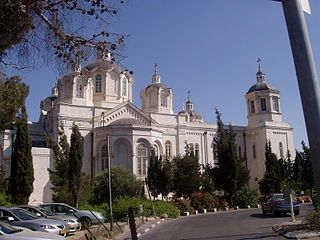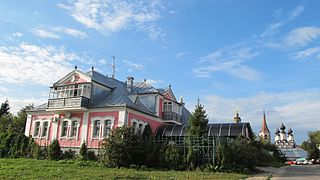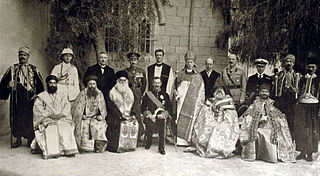Related Research Articles

The Russian Orthodox Church, alternatively legally known as the Moscow Patriarchate, is an autocephalous Eastern Orthodox Christian church. It has 194 dioceses inside Russia. The primate of the ROC is the Patriarch of Moscow and all Rus'.

Tikhon of Moscow, born Vasily Ivanovich Bellavin, was a bishop of the Russian Orthodox Church (ROC). On 5 November 1917 (OS) he was selected the 11th Patriarch of Moscow and All Russia, after a period of about 200 years of the Synodal rule in the ROC. He was canonised as a confessor by the ROC in 1989.

The Greek Orthodox Patriarchate of Jerusalem, also known as the Greek Orthodox Church of Jerusalem, is an autocephalous church within the wider communion of Eastern Orthodox Christianity. Established in the mid-fifth century as one of the oldest patriarchates in Christendom, it is headquartered in the Church of the Holy Sepulchre in Jerusalem and led by the patriarch of Jerusalem, currently Theophilos III. The patriarchate's ecclesiastical jurisdiction includes roughly 200,000 to 500,000 Orthodox Christians across the Holy Land in Palestine, Jordan and Israel.

The Russian Orthodox Church Outside of Russia, also called Russian Orthodox Church Outside Russia or ROCOR, or Russian Orthodox Church Abroad (ROCA), is a semi-autonomous part of the Russian Orthodox Church. Currently, the position of First-Hierarch of the ROCOR is occupied by Metropolitan Nicholas (Olhovsky).

The Catholic Church in Israel is part of the worldwide Catholic Church, in full communion with the Holy See in Rome. The Catholic Church in Israel is divided into three main jurisdictions: the Latin Patriarchate of Jerusalem, the Franciscan Custody of the Holy Land, and the Salesian Mission. Each of these jurisdictions has its own responsibilities and areas of operation.

The Russian Compound is one of the oldest districts in central Jerusalem, featuring a large Russian Orthodox church, the Russian-owned Sergei's Courtyard and the premises of the Russian Consulate General in Jerusalem, as well as the site of former pilgrim hostels, some of which are used as Israeli government buildings, and one of which hosts the Museum of Underground Prisoners. The compound was built between 1860 and 1890, with the addition in 1903 of the Nikolai Pilgrims Hospice. It was one of the first structures to be built outside the Old City of Jerusalem. The Bezalel Academy of Arts and Design's main campus is adjacent to the compound.
The timeline of Eastern Orthodoxy in North America represents a timeline of the historical development of religious communities, institutions and organizations of Eastern Orthodox Christianity in North America.

The Monastery of Saint George of Choziba, also known as Monastery ofChoziba or Mar Jaris, is a monastery located in Wadi Qelt in Area C of the eastern West Bank, in the Jericho Governorate of the State of Palestine. The cliff-hanging complex, which emerged from a lavra established in the 420s and reorganised as a monastery around AD 500, with its ancient chapel and irrigated gardens, is active and inhabited by Greek Orthodox monks. It houses the relics of Saint George of Choziba, after whom the monastery is named, as well as the relics of Saint John of Choziba (420/450–520/530) and those of Saint John of Choziba the Romanian (1913–1960).

The Church of the Holy Forefathers and Monastery of the Holy Trinity, also known as Al Maskobiya, is a Russian Orthodox monastery and church in Hebron, Palestine, founded in the 20th century on the site of the ancient Oak of Mamre.

The Oak of Mamre or Oak of Sibta at Khirbet es-Sibte or Ain Sibta in Hebron in the West Bank is a site venerated by some as the "Oak of Abraham". It is distinct from the more ancient site of Mamre. It owes its name to an ancient tree, which seems to be dead but has a young sprig growing next to it, and stands on the grounds of the modern Russian Orthodox Church Outside of Russia's Church of the Holy Forefathers and Monastery of the Holy Trinity.

Russian Orthodox properties in Israel refers to real-estate owned by the Russian Orthodox Church (ROC) in Israel.
Archimandrite Joasaph was an American scholar and priest of the Russian Orthodox Church Outside Russia in the last year of his life. From February 2009 until his death he served as Chief of the Russian Orthodox Ecclesiastical Mission in Jerusalem of the Russian Orthodox Church Outside Russia.
The Russian Orthodox Ecclesiastical Mission in Jerusalem was founded in the 19th century to serve as a representation of the Russian Orthodox Church to the Greek Orthodox Church of Jerusalem and to oversee the facilities caring for the thousands of pilgrims then flocking to the Holy Land from the Russian Empire.

Archbishop Elisey is the archbishop of the diocese of The Hague and the Netherlands of the Russian Orthodox Church (ROC). His monastic name, "Elisey", is the equivalent of the Latin Eliseus and the English Elisha.

The Russian Orthodox Autonomous Church is a Russian Orthodox church body headquartered in Suzdal, Russia. ROAC identifies as part of True Orthodoxy. In the Moscow Patriarchate, the ROCOR, and the mass media, it has the designation "Suzdal Schism".

The Holy Trinity Cathedral is a cathedral of the Russian Orthodox Church, located at the heart of the so-called Russian Compound in central Jerusalem. The cathedral was built in 1860–1872 by a Russian Orthodox Ecclesiastical Mission in Jerusalem, when the Holy City was part of the Ottoman Empire.
On 15 October 2018, the Russian Orthodox Church broke the communion with the Ecumenical Patriarchate because of a dispute concerning the canonical jurisdiction over Ukraine. This led to the 2018 Moscow–Constantinople schism. Numerous Orthodox churches took position concerning the dispute over the canonical jurisdiction over Ukraine, whether before or after this schism.

Metropolitan Mark, is a bishop in the Russian Orthodox Church. He holds the title of "Metropolitan of the Russian Orthodox Diocese of Ryazan and Mikhailovsky, head of the Ryazan Metropolis", as well as "Metropolitan of Budapest and Hungary".

The Holy and Ancient Archdiocese of Jerusalem, All Palestine, and All the Near East or the Coptic Orthodox Patriarchate in Jerusalem, is a Metropolitan Archdiocese of the Coptic Orthodox Church, which is part of the wider communion of the Oriental Orthodox Church. It is headed by the Coptic Orthodox Metropolitan Archbishop of Jerusalem, the incumbent being Metropolitan Archbishop Antonious of Jerusalem since 2016. Its jurisdiction covers those Coptic Orthodox Christians living in the Near East; with churches and monasteries in the State of Israel, State of Palestine, the State of Kuwait, the Hashemite Kingdom of Jordan, the Lebanese Republic, the Syrian Arab Republic, and the Republic of Iraq. The adherents are largely of Coptic Egyptian descent, mainland Coptic migrants and their descendants. The archdiocese is based at St Anthony's Monastery, in the Christian Quarter of the Old City of Jerusalem, beside the Church of the Holy Sepulchre.

Metropolitan Leonid is a retired bishop of the Russian Orthodox Church. He holds the title "Metropolitan of Klin". Former Patriarchal Exarch of Africa (2021-2023).
References
- 1 2 3 4 5 6 7 Catholic Encyclopedia - Jerusalem (After 1291). 1910.
- 1 2 Saint-Rene Taillandier (1866). "A Russian Mission in Palestine-Tischendorf and the Grand Duke Constantine". New York, NY: John A. Gray & Green.
- 1 2 3 4 5 "Plot in Progress". Time Magazine. September 15, 1952. Archived from the original on January 12, 2008. Retrieved 2009-08-06.
- 1 2 Blackwood's Edinburgh Magazine. Vol. CXXv. London: William Blackwood & Sons, Edinburgh. January–June 1879. p. 38.
- 1 2 3 4 5 6 7 Abigail Beshkin; Rob Mank (March 24, 2000). "Hunger strike in Jericho". Salon. Archived from the original on February 18, 2009. Retrieved 2009-08-06.
- 1 2 3 4 5 6 7 8 Jerrold Kessel (July 9, 1997). "Russian Orthodox strife brings change in Hebron". CNN.
- 1 2 3 "Palestinians Take Sides In Russian Orthodox Dispute". Catholic World News. July 9, 1997.
- 1 2 3 4 5 Russian Ecclesiastical Mission in Jerusalem (Moscow branch), list of properties
- ↑ Joe Dyke, Hebron's only church keeps the faith in turbulent city, on Your Middle East website, January 17, 2016
- ↑ WikiMapia, The Monastery of Holy Trinity Church (Hebron)
- 1 2 Official ROCOR Mission site [usurped]
- ↑ Official ROCOR Mission site [usurped]
- ↑ ROCOR Mission site, Skete of Saint Chariton - Fara [usurped]
